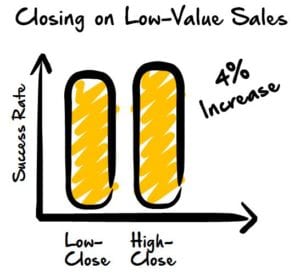Why Closing Gambits Don’t Work on Large Sales
Proponents of closing gambits would have you believe that these approaches can be applied effectively across a wide spectrum of sales—everything from rocket wreckage to everlasting Gobstoppers. Research suggests otherwise.
What Does The Data Say?
Neil Rackham discovered in his research that closing techniques can indeed be more effective when the scope of the sale is small.
What the study found is that when the value of the goods being sold was small, use of closing techniques both speeded the transaction time as well as the number of transactions resulting in a sale. The study showed in selling low-value goods, employing closing techniques improved performance by 4%.
However, as the value of the goods being sold increased, success in the transaction reversed and closing became counter-productive. So while attempts were up and transaction time was speeded in the study, overall success dropped measurably in the high-value goods arena.
Why Does This Happen?
Rackham describes the phenomenon this way, “The psychological effect of pressure seems to be this. If I’m asking you to make a very small decision, then—if I pressure—it’s easier for you to say yes than to have an argument. Consequently, with a small decision, the effect of pressure is positive. But this isn’t so with large decisions. The bigger the decision, the more negatively people generally react to pressure.”
Rackham went on to observe, “By forcing the customer into a decision, closing techniques speed the sales transaction.” And that, “Closing techniques may increase the chances of making a sale with low-priced products. With expensive products or services, they reduce the chances of making a sale.”
An Important Point
This is an important dynamic to be aware of when planning your efforts to close sales. With expensive products or services the use of closing gambits reduces the chances of making a sale.
What Is the Threshold?
So what is the threshold? At what price point do closing techniques become counter-productive? Amazingly, in Rackham’s study it was only $109.
While your situation may be different, all of the people I work with sell goods and services with values higher than this level. So if you are selling a lot of stuff lower than $109, maybe now is the time to whip out the Double-Reverse Close. On the other hand, if your solutions are somewhere north of this, the idea that using closing gambits is effective is not only wrong—it is counter-productive and will sabotage your closing efforts.
Closing Tip: With expensive solutions using closing gambits reduces your chances of making the sale.


